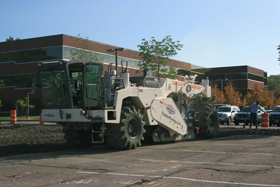Going Green From the Asphalt Up
Asphalt — a word that originates from the Greek word “asphaltos” for secure — is the most recycled material in America, with more than 70 million tons recycled each year.
One recycling method that offers cost savings in addition to its green benefits is full-depth reclamation — FDR — advocated by Ruston Paving Co., Inc.
In the FDR process, all of the asphalt pavement section and a predetermined amount of underlying materials are pulverized and blended to produce a stabilized base course. Different types of additives like asphalt emulsions, calcium chloride, Portland cement, fly ash and lime can be utilized for an improved base.
The process, which is typically performed at a depth of four to 12 inches, includes pulverization, introduction of additives, shaping of the mixed material, compaction and application of a surface or a wearing course.
Full depth reclamation has been recommended for pavements with a base or subgrade problem, deep rutting, load-associated cracks, nonload associated thermal cracks, reflection cracks, and pavements with maintenance patches. It can be done without changing the geometry of the area and can improve frost susceptibility.
With low production costs, low engineering costs, and only a wearing surface required on many projects, FDR also conserves materials and prevents air quality problems resulting from production fumes and transportation exhaust.
The process is used anywhere a facility has asphalt pavement, whether it’s parking lots for retail or private businesses, airport runways or military facilities.
FDR serves as an alternative to the traditional method — removing all the existing material, dumping it in a landfill and bringing in new material with little or no recycling involved in the process.
“Since you’re pulverizing and blending material in place, and creating a new material, nothing leaves the job site,” said Tim McConnell, pavement and soils specialist with Ruston Paving. “The green aspect is, you’re recycling the material in place, so it’s not wasted.”
The FDR process also reduces the costs and emissions from hauling away old material, trucking in new material, which adds to its green appeal, said Mark Ruston, president and CEO of the company.
“The process has been around for a long time, but in the past the type of equipment that was available only lent itself to roadway projects where you had continuous operations,” Ruston said. “Because we’re not a highway contractor and we mostly construct commercial parking lots, we struggled with trying to adapt the equipment and techniques to smaller, tighter areas.
The company’s major focus in the last few years has been on investing in more modern equipment that’s more agile, allowing the process to be adapted to smaller pavement situations.
“We’re now starting to see this take off in the commercial market,” Ruston said.
The expected life span of a section of pavement that’s been reclaimed is infinite as long as it’s maintained properly, he said.
“The expectation is that after 20 years you’re going to put another surface layer of asphalt over the top,” Ruston said. “But the base that’s been stabilized underneath should continue to last many decades.”
In terms of installation time, the FDR process takes about half the time that a traditional reconstruction would take.
Currently, FDR is employed mostly in projects where the local Department of Transportation has adopted the process, according to Lang Butler, vice president with Ruston Paving.
“One of the things we’re trying to do as a company is raise awareness that it is a viable option,” Butler said. “We are trying to get the process out there in the marketplace so that it becomes more of a common practice. Right now most of the work we’re doing is in our southern offices, but we are successfully doing projects in the northern markets as well. We are trying to get more people aware of it by sharing the successful projects we’ve been a part of.”
 The company, which was founded in 1943 in Syracuse, N.Y., has offices in New York, North Carolina and Virginia.
The company, which was founded in 1943 in Syracuse, N.Y., has offices in New York, North Carolina and Virginia.
“We see the future being bright because there’s a greater awareness of this green effort to conserve energy and natural resources. As oil prices go up along with the cost of hauling materials, it becomes a more attractive option,” Ruston said. “We see it as a growing market and that’s why we’re currently investing in better equipment so we can position ourselves for anticipated demand.”
As well as the FDR process, Ruston Paving offers soil stabilization as an additional green process.
“The thing that makes soil stabilization green is that on many sites, especially new construction sites, you may run into unsatisfactory soil conditions,” McConnell said. “The soil stabilization process has the ability to modify the soil that exists on site rather than the alternative — pulling that material off site, getting rid of it somewhere else and bringing in engineered aggregates and fill.”
Keeping material on site reduces the fossil fuel usage and emissions, which helps reduce a project’s carbon footprint, he said.
“When you start to affect areas outside of your work footprint, that’s when it becomes less and less sustainable,” he said. “The idea behind sustainability is to make sure that you’re only impacting a localized footprint.”
The onsite work included in both soil stabilization and FDR allow for cost savings since no new material needs to be purchased and brought on site.
“One of the advantages of the FDR process is that you’re actually creating a better product than the alternative, which would be full-depth excavation and replacement,” he said. “In addition to that, you’re also saving money.”
“In an industry that is typically associated with being environmentally detrimental in its required use of fossil fuels, it’s refreshing to be able to provide a product that is not only better for the environment but costs less to put in place,” Ruston said.
